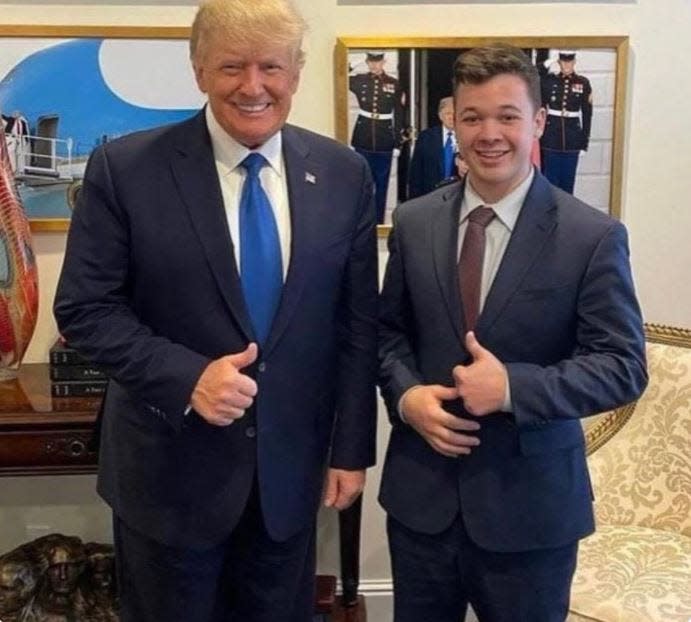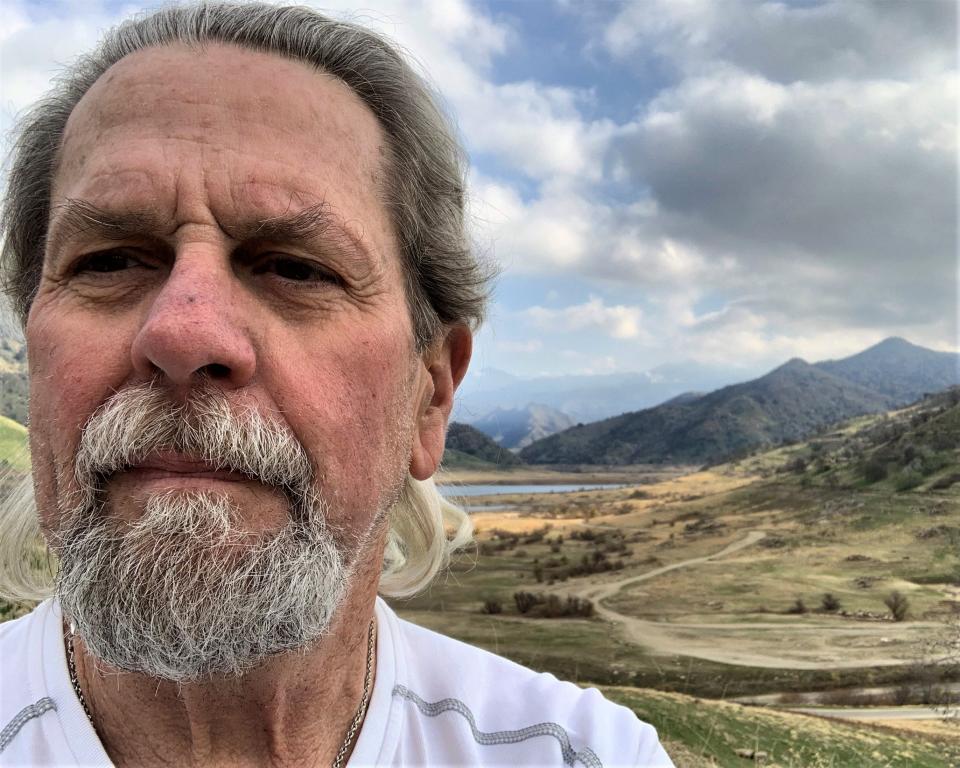Rittenhouse verdict has a lot to say about condition of America's soul

- Oops!Something went wrong.Please try again later.

When I was Kyle Rittenhouse’s age, there were protest marches about many things: The Bomb, Vietnam War, Civil Rights. Dogs and water hoses were used against those seeking equal rights and justice in the South, but the protests I marched in were peaceful. In the 1960s, with few exceptions, only the police packed guns.
Buffalo Springfield, headlining at Hollywood’s Whisky-A-Go-Go, featured 21-year-old Steven Stills and Neil Young, who cut “For What It’s Worth,” a song many artists have recorded since 1966. Angry property owners spearheaded a curfew law on Sunset Strip to discourage young people from gathering in the neighborhood:
The song reflected signs of the times, “battle lines are being drawn, nobody’s right if everybody’s wrong.” Pent-up emotion seemed to burst all at once during the Democratic Convention in Chicago in 1968. But guns were not prevalent even during those chaotic events. On May 4, 1970, at Kent State, four unarmed students were gunned down by National Guardsmen sent to quash protests against the Vietnam War.
Except for political assassinations, guns were never the centerpiece of conversation. Unheard of in those days, Columbine, Sandy Hook, and Parkland would become memorials to the innocent children and educators slaughtered with high-powered assault rifles made easily accessible to teenagers.
Where are we 50 years later? Far from Henry David Thoreau’s vision of civil disobedience and Gandhi’s and Martin Luther King, Jr’s ahimsa (non-violent) practice. No longer is “the man” the only one who carries a gun to rallies for social justice. Ordinary citizens arm themselves to attend, shadowing a constitutional amendment never meant to shield them from violating criminal laws.
So, whatever else may be said about his motives and intentions, 17-year-old Kyle Rittenhouse felt empowered to be on hand for protests in Kenosha two days after another police shooting of a Black man, Jacob Blake.
Following on the heels of George Floyd’s murder, temperatures were hot. With a vague sense of duty to protect anonymous property holders, Rittenhouse paraded the streets brandishing a human-slaughtering tool strapped to his shoulder: an AR-15 capable of firing 50 deadly rounds of full-metal-jacketed bullets in seconds. He did shoot and kill two men and maimed a third.
I do not quarrel with the right of self-defense, and I doubt there’s a jurist in the country who would advocate the abolition of the right. The right to use deadly force to defend one’s own life or come to the defense of another is well established where death or great bodily harm is imminent. Even when men carried swords and rode horses, the defense against criminal homicide charges required the defendant to “retreat to the [Castle] wall” before using deadly force.
The Retreat Rule was modified as guns replaced swords. Bullets traveled faster and at greater distances; retreat was no longer realistic. Though there is commonality, criminal laws vary from state to state, as do rules for self-defense, including for initial aggressors.
So-called “Stand Your Ground” laws, such as asserted by George Zimmerman in defense of his assault on Trevon Martin in Florida in 2012, are not new but are refashioned from the Retreat Rule.
Moreover, to address the “frailties of mankind,” an entirely new branch of homicide law evolved in the 18th Century to deal with intentional killings without malice aforethought (murder). Where passion upon adequate provocation or sudden quarrel, or an honest but unreasonable belief in the necessity to use deadly force, came into play, “manslaughter” filled a gap as a lesser-included offense to murder. The jury in Rittenhouse’s case was instructed on this law.
In several murder cases, I tried juries rejected murder charges but also rejected self-defense claims, returning manslaughter verdicts instead. The significance in California is reflected in sentencing laws — life in prison (or death) for murder downward to three, six, or eleven years for manslaughter — as a compromise to encompass those “frailties.”
Kyle Rittenhouse sobbed on the witness stand. It brought back a flood of memories for me. The credibility of the testimony is critical for the jury to understand the fear and reasonableness of the use of deadly force. I’ve called black, brown, and white teenagers and a 50-year-old man to the witness stand. In each case, the testimony has been emotional, and remorse expressed spontaneously, even if killing might have seemed the only way out at the time of the incident. Except for the truly remorseless, the trauma changes the soul whenever a man or woman takes another human life.
Americans are getting more opportunities to observe criminal trials. Far from perfect, most lawyers and judges are competent, but few are exceptional. The verdicts in Rittenhouse’s case were not the result of a quirky trial judge. As Mark Richards, lead defense counsel, noted after trial, he’s “butted heads” with Judge Bruce Schroeder for many years but gives both sides a level playing field.
Blaming District Attorneys Thomas Binger and James Kraus for failing to convince jurors beyond a reasonable doubt that Rittenhouse did not act in self-defense is the prerogative of Monday morning quarterbacks but are not likely to provide answers for the outcome of this tough case.
The real test for me is that jurors examined evidence over 26 hours and four days of deliberations. Jurors, attorneys, defendants, and judges, are the only ones in the courtroom every minute of trial.
Jurors reexamined the videos, witness testimony, arguments, and re-read instructions. Neither media representatives nor legal scholars viewed all of the evidence and did not bear the burden of decision. Whether we agree with the verdicts, the jury accepted the responsibility of citizenship sincerely.
Guns are not going away any time soon. But until we are willing to deepen the conversation about what guns are doing to America, we are doomed to repeat the vicious cycle of violence. We will continue to have the highest rate of deaths by gun violence in any country in the world. This is no time to “congratulate” Kyle Rittenhouse, as former President Donald Trump did: “If this isn’t self-defense, I don’t know what is.” Unlike the 2020 election, this was truly a close call, evidenced by the length of jury deliberations.
Rittenhouse is not a young person who showed courage on August 25, 2020, such as coming to the aid of the defenseless, and he is no hero. Bob Dylan’s famous gospel song, Gotta Serve Somebody (1979), calls us all to a higher law, “you may even own guns ..., but you’re gonna have to serve somebody.”
This young man will find no salvation in a Republican representative willing to exploit him and the tragedy at Kenosha, but I hope he continues in counseling and, more importantly, finds the one who is truly worth serving.
Phillip H. Cherney is a lawyer who has represented the infamous Oakland drug czar, Felix Mitchell, Richard Allen Davis in the Polly Klaas kidnap/murder case, and Joel Radovcich, whom Dana Ewell hired to kill his sister and parents in Fresno in 1992. He is an adjunct professor at San Joaquin College of Law.
This article originally appeared on Visalia Times-Delta: Rittenhouse verdict has a lot to say about condition of America's soul

